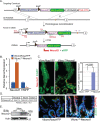Intestinal Neurod1 expression impairs paneth cell differentiation and promotes enteroendocrine lineage specification
- PMID: 31862906
- PMCID: PMC6925293
- DOI: 10.1038/s41598-019-55292-7
Intestinal Neurod1 expression impairs paneth cell differentiation and promotes enteroendocrine lineage specification
Abstract
Transcription factor Neurod1 is required for enteroendocrine progenitor differentiation and maturation. Several earlier studies indicated that ectopic expression of Neurod1 converted non- neuronal cells into neurons. However, the functional consequence of ectopic Neurod1 expression has not been examined in the GI tract, and it is not known whether Neurod1 can similarly switch cell fates in the intestine. We generated a mouse line that would enable us to conditionally express Neurod1 in intestinal epithelial cells at different stages of differentiation. Forced expression of Neurod1 throughout intestinal epithelium increased the number of EECs as well as the expression of EE specific transcription factors and hormones. Furthermore, we observed a substantial reduction of Paneth cell marker expression, although the expressions of enterocyte-, tuft- and goblet-cell specific markers are largely not affected. Our earlier study indicated that Neurog3+ progenitor cells give rise to not only EECs but also Goblet and Paneth cells. Here we show that the conditional expression of Neurod1 restricts Neurog3+ progenitors to adopt Paneth cell fate, and promotes more pronounced EE cell differentiation, while such effects are not seen in more differentiated Neurod1+ cells. Together, our data suggest that forced expression of Neurod1 programs intestinal epithelial cells more towards an EE cell fate at the expense of the Paneth cell lineage and the effect ceases as cells mature to EE cells.
Conflict of interest statement
The authors declare no competing interests.
Figures





Similar articles
-
Reduced Neurog3 Gene Dosage Shifts Enteroendocrine Progenitor Towards Goblet Cell Lineage in the Mouse Intestine.Cell Mol Gastroenterol Hepatol. 2021;11(2):433-448. doi: 10.1016/j.jcmgh.2020.08.006. Epub 2020 Aug 18. Cell Mol Gastroenterol Hepatol. 2021. PMID: 32822913 Free PMC article.
-
Cell Lineage metastability in Gfi1-deficient mouse intestinal epithelium.Dev Biol. 2010 Sep 1;345(1):49-63. doi: 10.1016/j.ydbio.2010.06.021. Epub 2010 Jun 20. Dev Biol. 2010. PMID: 20599897
-
Nutrient sensing by absorptive and secretory progenies of small intestinal stem cells.Am J Physiol Gastrointest Liver Physiol. 2017 Jun 1;312(6):G592-G605. doi: 10.1152/ajpgi.00416.2016. Epub 2017 Mar 23. Am J Physiol Gastrointest Liver Physiol. 2017. PMID: 28336548 Free PMC article.
-
Basic helix-loop-helix transcription factors and enteroendocrine cell differentiation.Diabetes Obes Metab. 2011 Oct;13 Suppl 1(0 1):5-12. doi: 10.1111/j.1463-1326.2011.01438.x. Diabetes Obes Metab. 2011. PMID: 21824251 Free PMC article. Review.
-
Minireview: Development and differentiation of gut endocrine cells.Endocrinology. 2004 Jun;145(6):2639-44. doi: 10.1210/en.2004-0051. Epub 2004 Mar 24. Endocrinology. 2004. PMID: 15044355 Review.
Cited by
-
Neurog1, Neurod1, and Atoh1 are essential for spiral ganglia, cochlear nuclei, and cochlear hair cell development.Fac Rev. 2021 May 11;10:47. doi: 10.12703/r/10-47. eCollection 2021. Fac Rev. 2021. PMID: 34131657 Free PMC article. Review.
-
NeuroD1 localizes to the presumptive ganglia and gut of the sea urchin larvae.MicroPubl Biol. 2022 Nov 15;2022:10.17912/micropub.biology.000682. doi: 10.17912/micropub.biology.000682. eCollection 2022. MicroPubl Biol. 2022. PMID: 36468156 Free PMC article.
-
Spatiotemporal analysis of human intestinal development at single-cell resolution.Cell. 2021 Feb 4;184(3):810-826.e23. doi: 10.1016/j.cell.2020.12.016. Epub 2021 Jan 5. Cell. 2021. PMID: 33406409 Free PMC article.
-
Neurogenin 2 and Neuronal Differentiation 1 Control Proper Development of the Chick Trigeminal Ganglion and Its Nerve Branches.J Dev Biol. 2023 Feb 19;11(1):8. doi: 10.3390/jdb11010008. J Dev Biol. 2023. PMID: 36810460 Free PMC article.
-
Cellular landscape of avian intestinal organoids revealed by single cell transcriptomics.Sci Rep. 2025 Apr 2;15(1):11362. doi: 10.1038/s41598-025-95721-4. Sci Rep. 2025. PMID: 40175530 Free PMC article.
References
Publication types
MeSH terms
Substances
Grants and funding
LinkOut - more resources
Full Text Sources
Other Literature Sources
Molecular Biology Databases
Research Materials

